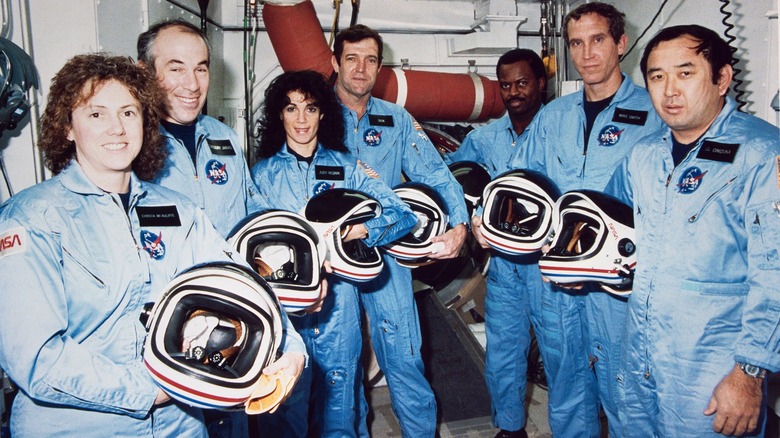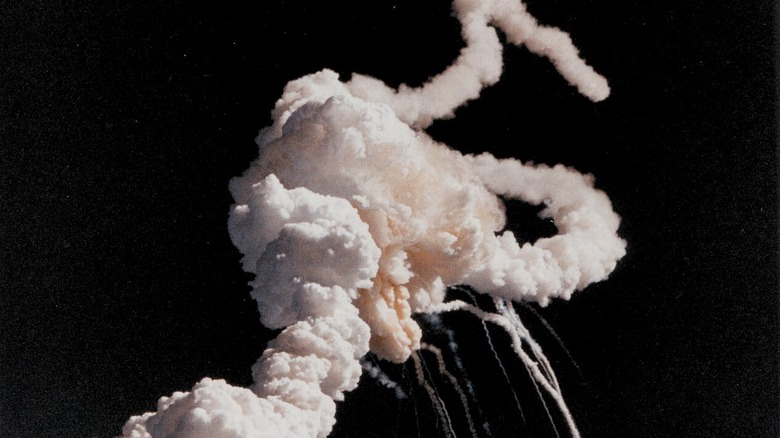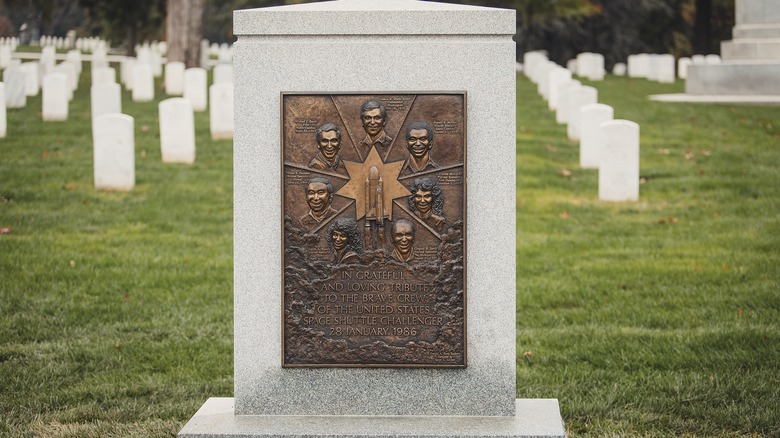The Chilling Final Words Of The Space Shuttle Challenger's Crew
The 1986 Challenger disaster was one of the worst space-related catastrophes in history. The seven crew members on board – Francis R. "Dick" Scobee, Michael J. Smith, Judith A. Resnik, Ronald E. McNair, Ellison S. Onizuka, Gregory B. Jarvis, and Christa McAuliffe — didn't even make it to space before their shuttle tore apart and its components exploded one by one. All seven either died on the way down to the Atlantic Ocean or when the broken remnants of their craft struck the surface of the water.
At the time, NASA remained respectfully silent about the recovery process of the crew member's bodies, and about the bodies themselves, saying merely, "Local security measures are being taken to assure that the recovery operations can take place in a safe and orderly manner," via The Washington Post, and that identification of the remains were being conducted at nearby Patrick Air Force Base Hospital south of Cape Canaveral.
Some schoolchildren saw the disaster unfold live on television from their classrooms, while others watched taped footage later. The voices of the crew, however, lived on. As the full transcript on NASA reads, the crew members did their jobs in their final five minutes of life, joked around a bit, seemed in bright spirits, and yes, commented on some irregularities in instrument readings. Pilot Michael J. Smith was the last to speak at 1 minute, 13 seconds after liftoff when he uttered the very chilling and simple phrase, "Uh-oh."
[Featured image by NASA via Wikimedia Commons | Cropped and scaled]
Voices of the dead
Four of Challenger's seven crew members have a voice in their mission's first and final five minutes: Commander Francis R. Scobee, Pilot Michael J. Smith, Mission Specialist Ellison S. Onizuka, and Mission Specialist Judith A. Resnik. In order, the mission's transcript labels these four individuals by their job: CDR, PLT, MS 1, and MS 2. The Challenger crew was unique because it included Christa McAuliffe, a teacher, and the first civilian in space selected for the mission out of 11,000 applicants.
The transcript starts a bit over three minutes before liftoff and mostly consists of small phrases and confirmations that crew members make between each other. NASA also chimes in with little statements and reminders here and there like, "Liquid oxygen supply arm to ET" at 1 minute, 47 seconds before launch, and, "Seat restraints" at 1 minute, 33 seconds before launch.
Crew members display joking and high spirits even while remaining professional and conducting life-or-death business. When NASA asks about the shuttle oxygen vent cap, for instance, Onizuka jokes, "Doesn't it go the other way?" and the whole crew laughs. When NASA tells the shuttle to start rolling 11 seconds into launch, Smith says (in true movie hero fashion), "Go you Mother." The helium in the right engine is lower than ideal but otherwise, everything else seems fine. At 1 minute, 10 seconds, Scobee tells Smith to throttle up. Three seconds later Smith mutters, "Uh-oh," and communications cut out that very second.
[Featured image by Kennedy Space Center via Wikimedia Commons | Cropped and scaled]
Ops recorders fill in the gaps
The transcript in question comes from operational recorder No. 2, a piece of equipment on space shuttles that usually gets reviewed after missions to help compose a full portrait of how things went. As UPI Archives details, investigators fished "ops recorder" No. 2 out of the Atlantic Ocean at a depth of 100 feet 18 miles offshore. The tape was cleaned and analyzed, and that's how we know what the crew of the Challenger said in their final minutes of life.
Besides helping us memorialize the Challenger's crew, the tape helped investigators identify exactly what caused the shuttle's destruction. If Pilot Michael J. Smith said "Uh-oh" before the Challenger broke apart, the reasoning went, then he (and perhaps the others) must have had some clue that something was wrong, even only for an instant. But even by then, there likely wasn't enough time to do anything about it.
Investigators revealed that the Challenger's O-rings were overly sensitive to temperature changes, got too cold the night before the launch, and ruptured during takeoff. As UPI Archives explains, these faulty O-rings caused a chain reaction that led to a hydrogen leak in Challenger's external, right rocket. At that moment, the craft's instruments might have indicated a reduction in pressure in the tank. But if Smith saw such readings, he didn't have a chance to do anything but leave behind some final words.
[Featured image by Pogribow via Wikimedia Commons | Cropped and scaled | CC BY-SA 4.0 DEED]


